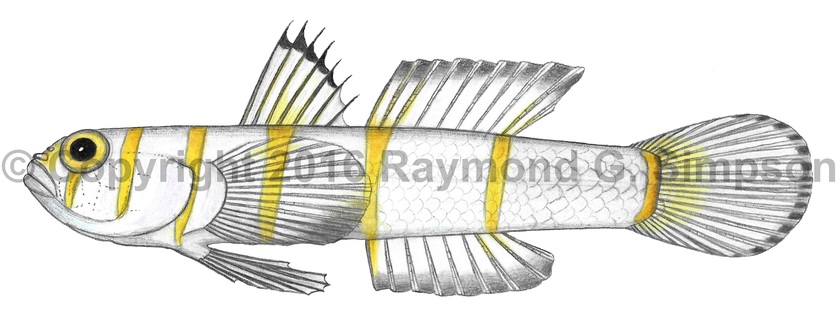
Common Name
Twilight Goby
Year Described
Van Tassell & Tornabene, 2016
Identification
Dorsal Fin: VII, 10
Anal Fin: 9
Pectoral Fin: 18
Caudal Fin: 17 segmented rays
Vertebrae: 11+16= 27 (total)
Body elongate with a large head. Eye medium sized. Dorsal fin with anterior spines not elongate and last two spines more spaced than the first five. Pelvic fin rays branched except for the last which is much shorter than fourth and unbranched. Pelvic rays with broad, fleshy tips. Pelvic fins not fused. One anal-fin pterygiophore anterior to the first haemal spine. Papillae rows 5i and 5s are connected as a single row. Cephalic lateralis pores absent. Body from pectoral base to caudal peduncle covered in ctenoid scales (cycloid anteriorly) in 21-24 rows. Scales on end of caudal peduncle enlarged. Two basicaudal scales present.
Color
Body and head white with a lavender hue. Body with five widely spaced narrow golden bands: the first behind the gill opening, the second under the spiny dorsal, the third under the soft dorsal origin, the fourth under the middle of the soft dorsal, and the last on the distal caudal peduncle. Head with a golden band behind head running to cheek. Eyeband present. Snout yellowish. Eye golden. Dorsal, anal, and caudal fins clear with bold white submarginal bands and black margins in male fish. Pelvic fin whitish. Pectoral fin pale yellowish to white with darker distal tip. Females almost entirely lack black pigments on fins.
Size
Maximum size to 60mm SL.
Habitat
The deepest living goby in the western Atlantic: taken between 250-500m depth on bare limestone and mixed rubble bottoms.
Range
Known from specimens taken off the Bahamas (San Salvador) and off Tobago.
References
Tornabene, L., J.L. Van Tassell, R.G. Gilmore, D.R. Robertson, F. Young, & C.C. Baldwin. 2016. Molecular phylogeny, analysis of character evolution, and submersible collections enable a new classification of a diverse group of gobies (Teleostei: Gobiidae: Nes subgroup), including nine new species and four new genera. Zoological Journal of the Linnean Society.
Other Notes
The only Varicus species in the region with branched pelvic fin rays (Tornabene et al, 2016).